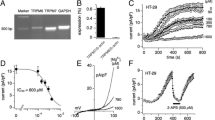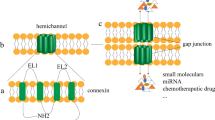Abstract
Okadaic acid (OA) is produced by several types of dinoflagellates (marine plankton) and has been implicated as the causative agent of diarrhetic shellfish syndrome. Previous studies have shown that okadaic acid is a tumor promoter and a specific potent inhibitor of protein phosphatases and protein synthesis. These effects in turn affect intracellular processes such as metabolism, contractility, gene transcription, and the maintenance of cytoskeletal structure. Gap junctional intercellular communication (GJIC) is a means of maintaining cellular homeostasis in organs, the disruption of which favors tumor cell growth. The GJIC involves the transfer of small water-soluble molecules through intercellular channels (gap junctions), composed of proteins called connexins. OA disrupts cellular homeostasis in Caco-2 cells through several mechanisms including protein synthesis inhibition, apoptosis, and clastogenic effects. The aim of this study was then to evaluate the expression of the connexin 43 (Cx 43) mRNA in relation with the cytotoxicity induced by OA (3.75–60 ng/ml) in a human colonic epithelial cell line in culture (Caco-2 cells). OA produced a dose-dependent inhibition of GJIC in Caco-2 cells, along with a parallel decrease in the expression of Cx 43 as shown by immunohistochemistry using anti-Cx 43 antibody. Since Cx 43 is implicated in the suppression of tumors and OA is a tumor promoter, the inhibition of GJIC may play an important role in its carcinogenesis. These data are discussed in relation to the toxicity of OA, total RNA synthesis, and possible specificity of Cx 43 inhibition in the GJIC.




Similar content being viewed by others
Abbreviations
- Cx:
-
Connexin
- OA:
-
Okadaic acid
- MTS:
-
2-(p-iodophenyl)-3-p-3-nitrophenyl-5-phenyltetrazolium
- GJIC:
-
Gap junctional intracellular communication
- DMEM:
-
Dulbecco's modified Eagle medium
- GAPDH:
-
Glyceraldehyde 3-phosphate dehydrogenase
- cDNA:
-
Complementary DNA
- mRNA:
-
Messenger RNA
- RT-PCR:
-
Reverse transcription polymerase chain reaction
- PBS:
-
Phosphate-buffered saline
- BSA:
-
Bovine serum albumin
References
Amzil Z, Pouchus YF, Le Boterff J, Roussakis C, Verbist JF, Marcaillou-Lebaut C, Masselin P (1992) Short-time cytotoxicity of mussel extracts: a new bioassay for okadaic acid detection. Toxicon 30:1419–1425
Baker TK, Kwiatkowski AP, Madhukar BV, Klaunig JE (1995) Inhibition of gap junctional intercellular communication by 2,3,7,8-tetrachlorodibenzo-p-dioxin (TCDD) in rat hepatocytes. Carcinogenesis 16:2321–2326
Berven G, Seatre F, Halvorsen K, Seglen PO (2001) Effects of diarrhetic shellfish toxin, okadaic acid, on cytoskeletal element, viability and functionality of rat liver and intestinal cells. Toxicon 39:349–362
Beyer EC (1993) Gap junctions. Int Rev Cytol 137:1–37
Boe R, Gjertsen BT, Vintermyr OK, Houge G, Lanotte M, Doskeland SO (1991) The protein phosphatase inhibitor okadaic acid induced morphological changes typical of apoptosis in mammalian cell. Exp Cell Res 195:237–246
Budunova IV, Carbajal S, Slaga TJ (1996) Effect of divers tumor promoters on the expression of gap-junctional proteins connexin (Cx) 26, Cx-31.1 and Cx-43 in SENCAR mouse epidermis. Mol Carcinog 15:202–214
Cesen-Cummings K, Fernstrom MJ, Malkinson AM, Ruch RJ (1998) Frequent reduction of gap junctional intercellular communication and connexin 43 expression in human and mouse lung carcinoma cells. Carcinogenesis 19:61–67
Ciminiello P, Fattorusso E, Forino M, Magno S, Poletti R, Viviani R (1999) Isolation of 45-hydroxyyessotoxin from mussels of the Adriatic sea. Toxicon 37:689–693
Cordier S, Monfort C, Miossec L, Richardson S, Belin C (2000) Ecological analysis of digestive cancer mortality related to contamination by diarrhetic shellfish poisoning toxins along the coasts of France. Environ Res 84:145–150
Fialkow L, Chan CK, Grinstein S, Downey GP (1993) Regulation of tyrosine phosphorylation in neutrophils by the NADPH oxidase. Role of reactive oxygen intermediates. J Biol Chem 268:17131
Fiorentini C, Matarrese P, Fattorossi A, Donelli G (1996) Okadaic acid induces changes in the organisation of F-actin in intestinal cells. Toxicon 34:937–945
Fujiki H, Suganuma M (1999) Unique features of the okadaic acid activity class of tumor promoters. J Cancer Res Clin Oncol 125:150–155
Guzman M, Castro J (1991) Okadaic acid stimulates carnitine palmitoyltransferase I activity and palmitate oxidation in isolated rat hepatocytes. FEBS Lett 291:105–108
IARC (1999) Overall evaluations of carcinogenicity to humans, IARC monographs (vol 1–73). IARC Scientific Publication, Lyon
Kenne K, Fransson-Steen R, Honkasalo S, Warngard L (1994) Two inhibitors of gap junctional intercellular communication, TPA and endosulfan: different effects on phosphorylation of connexin 43 in the rat liver epithelial cell line, IAR 20. Carcinogenesis 15:1161–1165
Klaunig JE, Ruch RJ (1990) Role of inhibition of intercellular communication in carcinogenesis. Lab Invest 62:135–146
Kojima T, Mitaka T, Mizuguchi T, Mochizuki Y (1996) Effects of oxygen radical scavengers on connexins 32 and 26 expression in primary cultures adult rat hepatocytes. Carcinogenesis 17:537–544
Kumar NM, Gilula NB (1996) The gap junction communication channel. Cell 84:381–388
Krutovskikh VA, Mesnil M, Mazzoleni G, Yamasaki H (1995) Inhibition of rat liver gap junction intercellular communication by tumor-promoting agents in vivo. Association with aberrant localization of connexin proteins. Lab Invest 72:571–577
Lerga A, Richard C, Delgrado MD, Canelles M, Frade P, Cuadrado MA, Leon J (1999) Apoptosis and mitotic arrest are two independent effects of the protein phosphatases inhibitor okadaic acid in K562 leukemia cells. Biochem Biophys Res Commun 24:256–264
Loktionova SA, Kabakov AE (1998) Protein phosphatase inhibitors and heat preconditioning prevent Hsp27 dephosphorylation, F-actin disruption and deterioration of morphology in ATP-depleted endothelial cells. FEBS Lett 433:294–300
Lozano Y, Taitz A, Petrzzelli GJ, Djordjevic A, Young MR (1996) Prostaglandin E2-protein kinase A signaling and protein phosphatases-1 and 2A regulate human head and neck squamous cell carcinoma motility, adherence, and cytoskeletal organisation. Prostanglandins 51:35–48
Matias WG, Traoré A, Creppy EE (1999a) Variations in the distribution of okadaic acid in organs biological fluids of mice related to diarrhoetic syndrome. Hum Exp Toxicol 18:345–350
Matias WG, Traoré A, Bonini M, Creppy EE (1999b) Oxygen reactive radicals production in cell culture by okadaic acid and their implication in protein synthesis inhibition. Hum Exp Toxicol 18:634–639
Matias WG, Creppy EE (1998) 5-Methyldeoxycytosine as a biological marker of DNA damage induced by okadaic acid in Vero cells. Environ Toxic Water Quality 13:83–87
Matias WG, Bonini M, Creppy EE (1996) Inhibition of protein synthesis in a cell free system and Vero cells by okadaic acid, a diarrhetic shellfish toxin. J Toxicol Environ Health 48:101–109
Okada T, Narai A, Matsunaga S, Fusetani N, Shimizu M (2000) Assessment of the marine toxins by monitoring the integrity of human intestinal Caco-2 cell monolayers. Toxicol In Vitro 14:219–226
Ren P, Mehta PP, Ruch RJ (1998) Inhibition of gap junctional intercellular communication by tumor promoters in connexin 43 and connexin 32-expressing liver cells: cell specificity and role of protein kinase C. Carcinogenesis 19:169–175
Ruch R (1994) The role of gap junctional intercellular communication in neoplasia. Ann Clin Lab Sci 24:216–231
Ruch RJ, Cesen-Cummings K, Malkinson AM (1998) Role of gap junctions in lung neoplasia. Exp Lung Res 24:523–539
Saez JC, Martinez AD, Branes MC, Gonzalez HE (1998) Regulation of gap junctions protein phosphorylation. Braz J Med Biol Res 31:593–600
Sai K, Kanno J, Hasegawa R, Trosko JE, Inoue T (2000) Prevention of gap junctional communication by green tea in the liver of mice fed pentachlorophenol. Carcinogenesis 12:1671–1676
Temme A, Traub O, Willecke K (1998) Downregulation of connexin 32 protein and gap-junction intercellular communication by cytokine-mediated acute-phase response in immortalized mouse hepatocytes. Cell Tissue Res 294:345–350
Traoré A, Bonini M, Dano DS, Creppy EE (1999a) Synergistic effects of some metals contaminating mussels on the cytotoxicity of the marine toxin okadaic acid. Arch Toxicol 73:289–295
Traoré A, Maeve L, Sanni A, Dano DS, Creppy, EE (1999b) Induction of apoptosis in human colonic epithelial cells (Caco-2) by okadaic acid (abstract of XXXVIIth European Congress of Toxicology EUROTOX 99 Oslo, June 27–30) (P202). Toxicol Lett 99 [Suppl 1]:73
Traoré A, Ambaliou S, Dano SD, Creppy EE (2000) Combined effects of okadaic acid and cadmium on lipid peroxidation and DNA bases modifications (m5dC and 8-(OH)-dG) in Caco-2 cells. Arch Toxicol 74:79–84
Trosko JE, Goodman JI (1994) Intercellular communication may facilitate apoptosis: implications for tumor promotion. Mol Carcinog 11:8–12
Trosko JE, Ruch RJ (1998) Cell-cell communication in carcinogenesis. Front Biosci 3:208–236
Turk PW, Laayoun A, Smith SS, Weitzman SA (1995) DNA adduct 8-hydroxy-2'-deoxyguanosine (8-hydroxyguanine) affects function of human DNA methyltransferase. Carcinogenesis 16:1253–1255
Upham BL, Kang KS, Cho HY, Trosko JE (1997) Hydrogen peroxide inhibits gap junctional intercellular communication in glutathion sufficient but not glutathion deficient cells. Carcinogenesis 18:37–42
Wachsman JT (1997) DNA methylation and the association between genetic and epigenetic changes: relation to carcinogenesis. Mutat Res 375:1–8
Yamasaki H (1995) Non-genetic mechanisms of carcinogenesis: studies of cell transformation and gap junctional intercellular communication. Toxicol Lett 77:545–561
Acknowledgements
The study described was supported in part by the French Institute of Marine Research (IFREMER), 1 Quai du Commandant Silhouette, 33120 Arcachon (IFREMER, PNEAT, n° 96-5 411452, 1996) France, University Bordeaux 2, France. The authors are grateful to the French National Academy of Medicine for the award of Elisabeth Taub to Professor E.E. Creppy.
Author information
Authors and Affiliations
Corresponding author
Rights and permissions
About this article
Cite this article
Traoré, A., Baudrimont, I., Dano, S. et al. Epigenetic properties of the diarrhetic marine toxin okadaic acid: inhibition of the gap junctional intercellular communication in a human intestine epithelial cell line. Arch Toxicol 77, 657–662 (2003). https://doi.org/10.1007/s00204-003-0460-0
Received:
Accepted:
Published:
Issue Date:
DOI: https://doi.org/10.1007/s00204-003-0460-0




